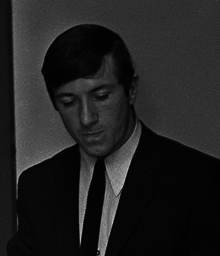George Armstrong (footballer)

Armstrong pictured in 1967
|
|||
| Personal information | |||
|---|---|---|---|
| Full name | George Armstrong | ||
| Date of birth | 9 August 1944 | ||
| Place of birth | Hebburn, County Durham, England | ||
| Date of death | 1 November 2000 (aged 56) | ||
| Place of death | Hemel Hempstead, Hertfordshire, England | ||
| Height | 5 ft 6 in (1.68 m) | ||
| Playing position | Winger | ||
| Senior career* | |||
| Years | Team | Apps | (Gls) |
| 1961–1977 | Arsenal | 500 | (53) |
| 1977–1978 | Leicester City | 15 | (0) |
| 1978–1979 | 34 | (0) | |
| Teams managed | |||
| Enderby Town | |||
| FK Mjølner | |||
| 1988–1989 | Kuwait | ||
| * Senior club appearances and goals counted for the domestic league only. |
|||
George "Geordie" Armstrong (9 August 1944 – 1 November 2000) was an English football player and coach, primarily associated with Arsenal. A winger, Armstrong made his Arsenal debut in 1962 at the age of 17 and made 621 appearances – which was then an all-time club record – before leaving in 1977. He spent a season each with Leicester City and , and then took up coaching, both domestically and abroad. After a year as Kuwait national team manager, Armstrong returned Arsenal as reserve-team coach in 1990, a post he held for the remaining ten years of his life.
Armstrong was born in Hebburn, County Durham. After leaving school he took up an apprenticeship as an electrician and played in works football. He had an unsuccessful trial with Grimsby Town, and signed amateur forms for Newcastle United, before signing for Arsenal.
He arrived as an inside forward but was soon switched to the wing. He made his debut not long after joining the club; while still only 17, he started against Blackpool on 24 February 1962 in a match that Arsenal won 1–0. Although he started out as understudy to Johnny MacLeod and Alan Skirton, by the 1963–64 season he had become a regular in the side, and in 1964–65 he missed only two matches.
Over his long career with the Gunners, Armstrong became one of Arsenal's most consistent players, who was noted for the quality and accuracy of his crossing and corner kicks, as well as for his tireless running up and down the wing; he primarily played on the left, but was also effective on the right. Signed by George Swindin but maturing under Billy Wright's management, he was one of a group of players from the Wright era (along with Jon Sammels and Peter Storey) to become an integral part of Wright's successor Bertie Mee's Arsenal side, which ended the club's long trophy drought.
...
Wikipedia
